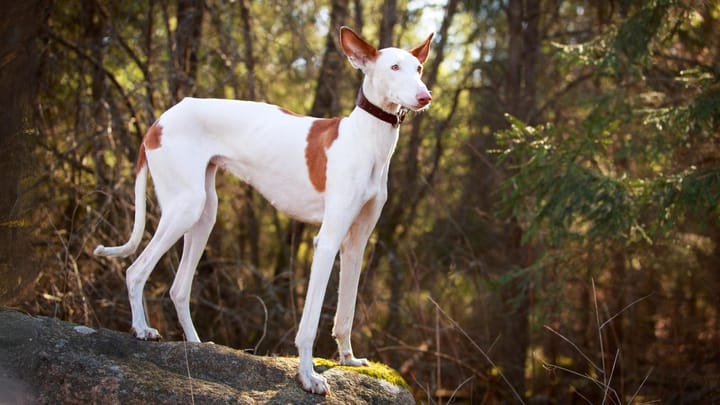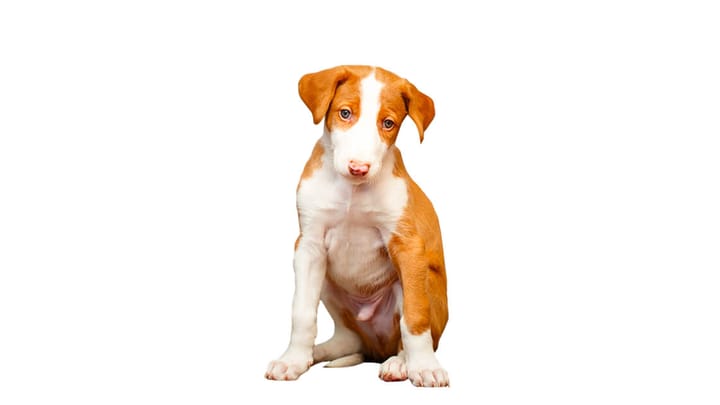Ibizan Podenco
Other name: Canary Islands Hound


The Canary Islands Dog is better known as the Podenco Canario on their island of origin. They are a particularly brave, lively, enduring and very dynamic breed. Naturally quite nervous, they are active dogs that can only thrive with a sporty master who can give them time.
|
Life expectancy |
The Ibizan Podenco has a life expectancy of between 10 and 12 years |
|
Temperament |
|
|
Size |
Large
|
|
Adult size |
Female
Between 24 and 26 in
Male
Between 26 and 28 in
|
|
Adult weight |
Female
Between 42 and 51 lb
Male
Between 42 and 51 lb
|
|
Coat colour
Their coat colour is a two-toned red (from orange to mahogany) and white. |
White Red |
|
Type of coat
They have a short coat. Their coat is smooth and dense. |
Short Hard Long |
|
Eye colour
Their eyes are green. |
Brown
|
The Canary Islands Hound, much like their counterparts the Ibizan Hound and other Portuguese and Spanish hunting dogs, is often mistreated by the locals who use them for hunting. If they are deemed not efficient enough, these dogs are hung for disgracing their handler. Many associations are trying to fight against the use of these dogs as simple “slave dogs” that are quickly discarded and thrown out when they fail.
More details about the Ibizan Podenco
Ibizan Podenco: Origins and history
The Canary Islands Hound is one of the oldest known species : they date back about 7,000 years, as shown by the engravings, statues and carvings in which they appear. Originally from Egypt, they were most likely exported to the Canary Islands by the Phoenicians, Greeks, Carthaginians and the Egyptians themselves. They are widespread in the Canary Islands, particularly on the largest of the islands (Gran Canaria and Tenerife).
Physical characteristics of the Ibizan Podenco
The Canary Islands Hound, more commonly known as Podenco Canario, is an average-sized, slender and lightweight dog that is also very resilient. Their muscles are well developed and lean, without any trace of fat, to the point where you can see their ribs, spine and the bones of their hips. Their head is elongated and narrow, with a slightly accentuated stop. Their eyes are slanted, small and almond shaped, with an intelligent and noble look. Their rather large ears are raised when they are excited and thrown back when resting. They are broad at the base and come together at the tip in a slightly conflicting position. Their legs are perfectly straight, with an acute but solid bone structure. The tail is set low, it either hangs low or is raised in a rounded sickle shape and it does not extend beyond their hind legs.
FCI classification of the Ibizan Podenco
-
Group 5 - Spitz and primitive types
-
Section 7 : Primitive type - Hunting Dogs
Ibizan Podenco: Characteristics
Ibizan Podenco: Behaviour
Training a Ibizan Podenco
They are generally easier to train if you start early and use a well balanced soft, yet firm approach. As puppies, they must be closely guided in order to prevent their natural excitement turning into uncontrollable energy.
It is important to gradually increase their social interaction, this avoids them being shy or even toxic towards strangers.
Ibizan Podenco: Lifestyle
Breed compatibility Ibizan Podenco
Ibizan Podenco: Purchase price
The price of a Canary Islands Hound varies according to its origin, age and gender. It is a less well known breed and they are widespread outside their country of origin, so it is difficult to know the fair price to pay.
On average, the recommended budget to support a dog of this size is around £35/month.
Ibizan Podenco: Shedding
Light
Hair loss is minimal for this breed and moulting is very light and insignificant.
Ibizan Podenco: Grooming
These short-haired dogs do not require any grooming, except an occasional brushing to maintain their well groomed coat.
Ibizan Podenco: Health
The average life expectancy for this breed is 11 years.
These dogs are hardy, robust and enjoy being healthy.
Given their origins, these dogs are used to high temperatures and adapt very well to occasional extreme weather conditions.
Rough climates, on the other hand, are much less appreciated by this southern breed. Even considering they are tough dogs, it is better not to leave them outside for too long when temperatures are too low.
Thanks to their dynamic nature, they rarely gain weight.
As this is the case, it is important to pay close attention to their need to exercise as they must keep their lean and athletic look.
No particular disease affects this breed.





